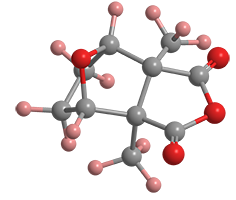What molecule am I?


Cantharidin1 is a tricyclic alkaloid that contains anhydride and ether groups. It is a virulent toxin produced by blister beetles of the family Meloidae, mostly in the genus Epicauta.
An early mention of cantharidin in the chemical literature came in an 1878 article by British physician/chemist Alexander Wynter Blyth, who determined the sublimation temperatures of some alkaloids and similar compounds. (Cantharidin sublimes at 110 °C under 12-Torr pressure.) Twenty years later, physician Francis Whitaker Tunnicliffe at St. Bartholomew’s Hospital (London) described cantharidin as a “vascular tonic” (vesicant, or blister former) for treating tuberculosis and lupus.
It was not until 1953 that the presence of cantharidin in blister beetles was documented. Taiwanese chemist Hung-Yuan Hsu reported that the content of the molecule in the Formosan blister beetle (genus Maloe) was 0.97%. In a more complete analysis in 1967, Wilbert G. Walter and John F. Cole at the University of Mississippi (Oxford) described the isolation of the active principle of the North American blister beetle Epicauta pestifera and their determination that it was cantharidin.
Hundreds of articles in subsequent years described the toxic nature of cantharidin. It does, however, have a few medical uses, mainly as a topical treatment for warts, but also as an abortifacient (abortion inducer) and a veterinary diuretic. Notoriously, it is also the active ingredient in “Spanish fly” an ancient, risky, and not always effective aphrodisiac.
In 2001, Lisa Moed, Tor A. Shwayder, and Mary Wu Chang* at New York University School of Medicine (New York City) wrote an extensive review titled “Cantharidin Revisited: A Blistering Defense of an Ancient Medicine”. In their section on cantharidin’s history with the US Food and Drug Administration (FDA), they noted that the drug was first registered in the 1950s, when the agency did not require efficacy data. After a 1962 amendment to the original FDA act of 1938 required efficacy data , the agency took cantharidin off the market because no data had been submitted. (In July 2023, long after the review was published, FDA reinstated cantharidin as a topical for treating molluscum contagiosum [“water warts”].)
Chang et al.’s 2001 defense of cantharidin was that it is a safe drug when properly used. They cited a 1995 article by Stefan Herzig, Martin Tepel, and co-workers at University Hospital Eppendorf (Hamburg, Germany), who reported that the compound, a phosphatase inhibitor, acts as a vasoconstrictor and positive inotrope (muscle strengthener) in guinea pigs and in vitro in human cardiac tissue. Based on these results, they conjectured that less toxic derivatives of cantharidin could be therapies for treating human cardiac failure.
1. Scifindern: 4,7-epoxyisobenzofuran-1,3-dione, hexahydro-3a,7a-dimethyl-, (3aR,4S,7R,7aS)-rel-.
Cantharidin hazard information
| Hazard class* | GHS code and hazard statement | |
|---|---|---|
| Acute toxicity, oral, category 2 | H300—Fatal if swallowed | |
| Skin corrosion/irritation, category 2 | H315—Causes skin irritation | |
| Serious eye damage/eye irritation, category 2A | H319—Causes serious eye irritation | |
| Specific target organ toxicity, single exposure, respiratory tract irritation, category 3 | H335—May cause respiratory irritation | |
*Globally Harmonized System (GHS) of Classification and Labeling of Chemicals. Explanation of pictograms.
This molecule was suggested by a reader. We present almost all of the molecules suggested by our readers. If you have a molecule you would like us to consider, please send us a message. And thank you for your interest in Molecule of the Week! —Ed.
Cantharidin fast facts
| CAS Reg. No. | 56-25-7 |
| Empirical formula | C10H12O4 |
| Molar mass | 196.20 g/mol |
| Appearance | White crystals or powdera |
| Melting point | 218 °C |
| Water solubility | 31 mg/L (20 °C) |
MOTW update
Lisdexamfetamine1 was the Molecule of the Week for March 4, 2008. It is a prodrug for treating attention deficit hyperactivity disorder (ADHD) that was approved by FDA in 2007. Under the trade name Vyvanse, it is an alternative to the more commonly used drug Adderall.
Whereas Adderall is a combination of salts of racemic amphetamine2 and its enantiomer D-amphetamine3, lisdexamfetamine is a single molecule consisting of dextroamphetamine coupled with L-lysine4. In a 2022 article, Richard Crabbe at Free by the Sea drug and alcohol recovery center (Ocean Park, WA) explained the differences between Adderall and Vyvanse5.
Among the differences is that Vyvanse is significantly slower to be absorbed by the body than Adderall because it must first release D-amphetamine. Vyvanse’s slower absorption rate, however, leads to fewer side effects than Adderall.
In 2015, FDA approved Vyvanse for treating binge eating disorder. Last August, FDA approved generic lisdexamfetamine as an alternative to brand-name Vyvanse.
1. CAS Reg. No. 608137-32-2.
2. CAS Reg. No. 300-62-9.
3. CAS Reg. No. 51-64-9.
4. CAS Reg. No. 56-87-1.
5. Our thanks to a reader who sent this article to MOTW.

Learn more about this molecule from CAS, the most authoritative and comprehensive source for chemical information.
Molecule of the Week needs your suggestions!
If your favorite molecule is not in our archive, please send us a message. The molecule can be notable for its current or historical importance or for any quirky reason. Thank you!
Stay Ahead of the Chemistry Curve
Learn how ACS can help you stay ahead in the world of chemistry.

